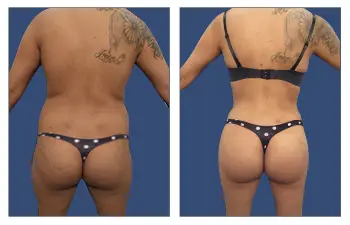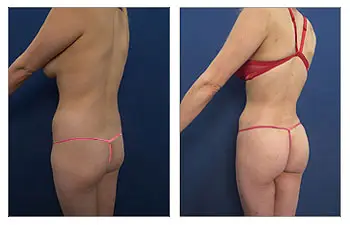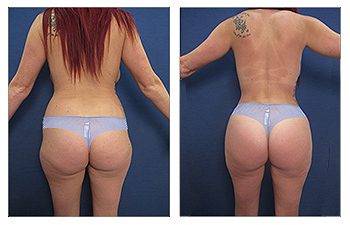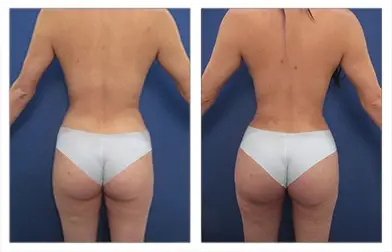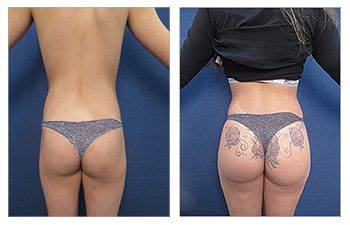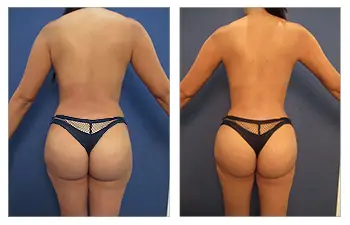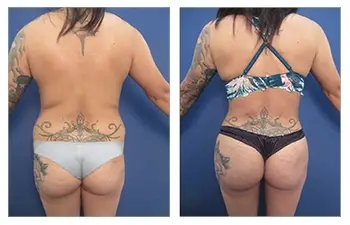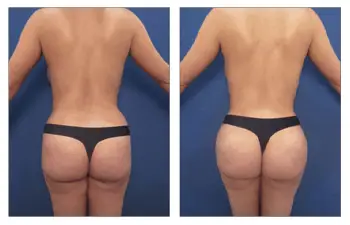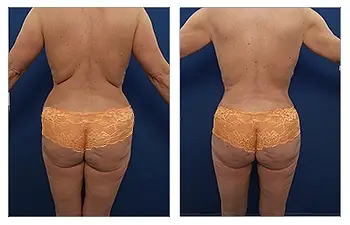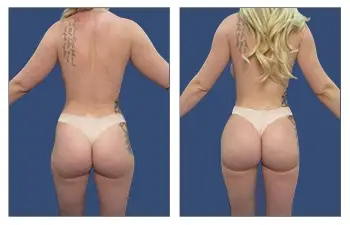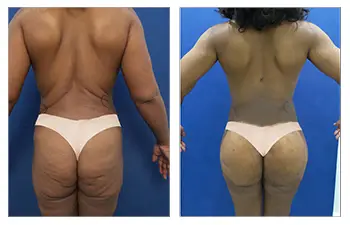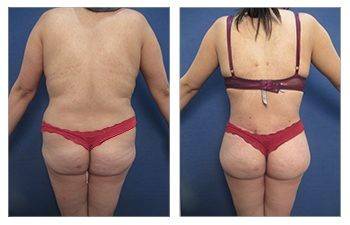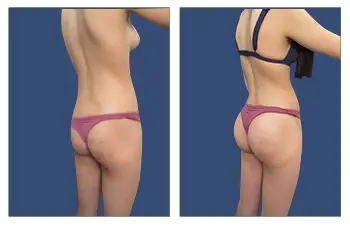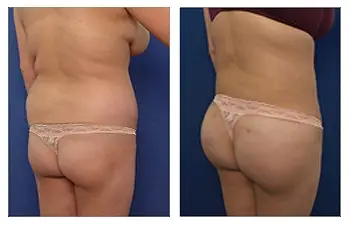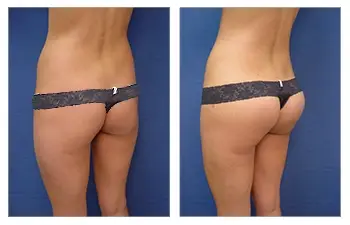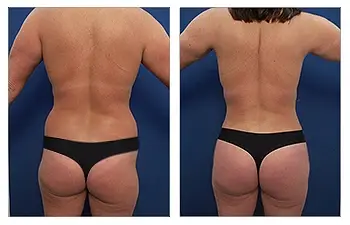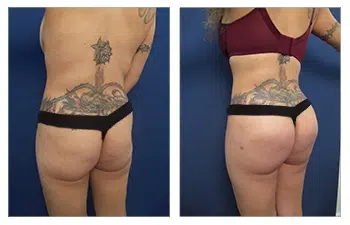Intro to What is the Preferred Location of Fat Transfer in BBL Surgery
In BBL (Brazilian Butt Lift) surgery, the preferred locations for fat transfer harvests are those areas of the body with excess fat deposits, such as the abdomen, back, and thighs. During this procedure, liposuction is performed to harvest fat from these areas, not only enhancing the volume of the buttocks but also sculpting a more contoured overall figure. The goal is to achieve buttock augmentation while ensuring that the silhouette complements the patient’s natural shape.
The harvested fat goes through a careful purification process before being re-injected into the buttocks. This method of fat grafting ensures that the results are natural-looking and well-integrated into the body. By strategically targeting excess fat and transferring it to the desired location, BBL surgery can create a harmonious balance between the body’s proportions, enhancing both the buttocks and the curves of the overall figure. This meticulous approach underscores the importance of aesthetic balance in achieving the desired results.
The final step involved in BBL involves determining the location of fat transfer in the buttock region. The location of fat transfer in BBL surgery is partially subjective and dependent on the patient’s desires and partially functional. Subjective, cosmetic influences for fat transfer include choosing between the central buttock cheek, the lateral buttock cheeks, and the hip dips, and communicating each patient’s unique desires can be clarified using the Brazilian Butt Lift Calculator. Next, the functional component of fat transfer location involves the depth of fat transfer. This blog was written to clarify the location of fat transfer in BBL surgery.
Fat transfer Location Area Options in BBL Surgery
In the realm of Brazilian Butt Lift (BBL) surgery, fat transfer plays a pivotal role in enhancing the aesthetic appeal of the buttocks while simultaneously contouring other areas of the body. This innovative procedure involves the careful extraction of excess fat from specific donor sites, such as the abdomen, thighs, or flanks, which are then purified and strategically injected into the gluteal region. Choosing the right fat transfer locations is crucial, as it not only defines the overall body silhouette but also ensures a more seamless and natural-looking result.
This introductory guide delves into the various location area options for fat transfer in BBL surgery, highlighting their significance in achieving a balanced and curvaceous figure. Whether seeking to slim down certain areas or enhance volume in the buttocks, understanding these options can empower individuals to make informed decisions about their body transformation journey.
Central Buttock Cheek
The central buttock cheek plays a crucial role in achieving a fuller, more rounded appearance in a Brazilian Butt Lift (BBL). This area is key for providing volume and projection, contributing significantly to an aesthetically pleasing silhouette. By focusing on the central buttock cheek during the procedure, surgeons can enhance the buttock’s overall shape and make it appear more youthful and lifted.
Individual needs and desired results vary, allowing the central buttock cheek to accommodate differing amounts of harvested fat. This adaptability is essential for creating a personalized and natural outcome, as each patient has unique contours and preferences.
Fat grafting is pivotal in this process, as it not only enhances volume in the central buttock cheek but also ensures proper fat placement for optimal healing. When done correctly, fat grafting promotes healthy blood flow to the transplanted fat cells, maximizing their survival and maintaining a desirable shape. Thus, the emphasis on the central buttock cheek during a BBL is vital for achieving the intended balance, volume, and projection in the final result.
Lateral Buttock Cheek
The lateral buttock cheek plays a crucial role in achieving a fuller and more rounded appearance during a Brazilian Butt Lift (BBL). By focusing on this area, surgeons can enhance the overall contour and projection of the buttocks, resulting in a shapelier silhouette. Fat transfer to the lateral buttock augmentations not only provides volume but also creates a more balanced proportion between the hips and thighs, making the body appear more aesthetically pleasing.
Liposuction is integral to the BBL procedure, as it allows for the precise removal of fat from predetermined areas, which can then be processed and injected into the lateral buttock. The surgeon’s technique in harvesting and injecting fat is vital; proper cannula placement and depth ensure that the transferred fat cells integrate successfully, leading to optimal results and longevity of the enhancement.
It’s important to note that the amount of fat that can be transferred varies based on individual anatomy and desired outcomes. Some patients may require a more significant volume for effective enhancement, while others may achieve their goals with less. This customization is key to achieving the most natural and flattering results in a BBL.
Hip Dips
Hip dips, also known as “violin hips,” are natural indentations that occur on the sides of the hips, primarily influenced by the shape of the pelvis and fat distribution in the body. Anatomically, the hip structure is determined by the width of the pelvis and the arrangement of muscle and fat tissue, leading to these indentations in many individuals.
It’s important to recognize that hip dips are a common and normal body feature, not indicative of obesity or weight issues. They exist across a spectrum of body shapes and sizes, highlighting the diversity of human anatomy.
Emphasizing body positivity is crucial in embracing our unique features, including hip dips. Celebrating diverse body shapes fosters a healthy self-image and encourages acceptance of all bodies, regardless of their specific characteristics. Remember, it’s essential to love and appreciate our bodies as they are, promoting a mindset that values individuality and self-acceptance.
However, filling of the hip dips is a common desire and will result in optimizing her contour with creation of the perfect female silhouette. As such, filling of the hip dips has become popularized.
Fat Transfer Depth Options in BBL Surgery
The Brazilian Butt Lift (BBL) is a popular cosmetic procedure that enhances the volume and shape of the buttocks through fat transfer. One of the most appealing aspects of BBL surgery is the versatility it offers through various fat transfer options. This innovative approach allows surgeons to harvest fat from areas of the body where it may be unwanted, such as the abdomen, thighs, or flanks, and subsequently inject it into the buttocks for a fuller, more contoured appearance. Unlike the region of fat transfer, the choice in the depth of fat grafting is not variable and limited to injection in the deep fat layer preferentially to the superficial fat layer.
Superficial Fat Layer
The superficial fat layer, also known as subcutaneous fat, plays a critical role in the body’s structure and function. Located just beneath the skin, this layer serves multiple purposes, including thermoregulation, where it helps maintain body temperature by insulating against cold environments, and energy storage, providing a reserve of calories for metabolic needs.
Compositionally, the superficial fat layer consists primarily of adipocytes, or fat cells, which can vary significantly across different regions of the body. For instance, individuals may have thicker subcutaneous fat in areas like the abdomen and thighs compared to the arms or face. This variability not only influences body composition but also carries important health implications; excess subcutaneous fat can be linked to increased risks of metabolic disorders, cardiovascular diseases, and obesity.
Understanding the characteristics of the superficial fat layer is essential, as it directly relates to overall health. Monitoring subcutaneous fat levels can provide valuable insights into an individual’s metabolic health and help in developing tailored strategies for weight management and disease prevention.
Fat grafting in this layer must be performed conservatively, as generous transfer of fat in this layer may results in contour irregularities.
Deep Fat Layer
In the Brazilian Butt Lift (BBL) fat grafting procedure, the deep fat layer plays a crucial role in achieving optimal results and natural aesthetics and is the main target for fat grafting. By targeting this deeper layer during fat harvesting, surgeons can ensure a sufficient volume for successful augmentation of the buttocks, which is essential for enhancing the overall contour and shape.
Harvesting fat from the deep fat layer not only provides ample volume for injection but also contributes to the longevity of the grafted fat, minimizing the risk of resorption and maximizing the durability of the results. This technique allows for strategic placement within the buttocks, ensuring that the newly added volume blends seamlessly with the surrounding tissue, enhancing the natural appearance.
Additionally, an understanding of the deep fat layer informs the technique used during fat grafting, enabling surgeons to optimize fat distribution and achieve enhanced outcomes. By utilizing this knowledge, practitioners can create a full, yet natural-looking silhouette, thus elevating the overall results of the BBL procedure. The emphasis on volume enhancement from the deep fat layer is integral to achieving the desired aesthetic outcomes in this popular procedure.
Intramuscular?
Intramuscular injections (IM injections) involve delivering medication directly into a muscle, allowing for faster absorption into the bloodstream compared to oral routes. This method is significant for administering medications that require rapid onset or larger volumes than subcutaneous routes can handle. Common uses include vaccinations, hormonal therapies, and certain antibiotics.
However, the injection of fat into the intramuscular level is not allowed today. This is because fat transferred to this region has the potential to migrate into submuscular layer where fat becoming sucked into the gluteal veins is feasible. Inadvertent infragluteal veins can result in a detrimental consequence of pulmonary emboli. The reason why intramuscular fat grafting has a propensity for migration of fat into the submuscular plane is the void a a protective posterior gluteal maximus fascia which would act as a barrier if it were present.
Submuscular?
Submuscular placement of fat is forbidden as this location for fat grafting has been established as the single most risk for fat emboli. Fat emboli results from the negative pressure created in this space through a concept called the Bernulli effect. What it describes is the creation of a negative pressure that will suck elements from the submuscular layer into the infragluteal vein if there is even a small tear of the vessel. A fat emboli can result in a detrimental pulmonary emboli.
Will I need several fat transfer sessions?
The necessity for multiple fat transfer sessions largely depends on the size of the treated area and the desired volume you wish to achieve. For instance, enhancing the lips typically requires just one session to create noticeable and satisfying results. In contrast, procedures like breast enhancement or buttock enhancement may necessitate multiple surgeries to attain the desired fullness and contour.
The process involves transferring fat from one area of the body to another, and larger areas may require more than one session to achieve the best outcome. It’s crucial to understand that individual anatomy and goals significantly influence the number of sessions needed.
Consulting with a qualified plastic surgeon is essential to assess your specific needs and develop a tailored treatment plan. They will provide guidance on the expected results, potential recovery time, and the number of sessions that may be necessary for your fat transfer journey. Prioritizing this consultation will ensure a safe and effective approach to achieving your aesthetic goals.
Volumes of Fat Transfer in BBL Surgery
In Brazilian Butt Lift (BBL) surgery, the typical volumes of fat transfer used can vary significantly, often ranging from 200 to 800 cc of processed fat injected into the buttocks for augmentation and contouring. Surgeons typically harvest fat from donor areas such as the abdomen, back, or thighs, with amounts ranging from 1 to 4 liters, depending on the individual’s body type and goals.
The specific volume of fat harvested and transferred is tailored to each patient’s desired fullness and contour. Patients aiming for a more dramatic enhancement may require larger volumes, while those desiring subtle augmentation may need less. It’s essential for some individuals to undergo multiple procedures to achieve their ideal results, especially if substantial volume is needed or if a more gradual approach is preferred.
Overall, the success of BBL fat transfer relies on careful assessment of the patient’s anatomy and aesthetic aspirations, ensuring a proportionate and harmonious outcome.
Fat Transfer in BBL Surgery Results
Fat transfer in Brazilian Butt Lift (BBL) surgery offers transformative outcomes beyond just buttock augmentation. The procedure involves harvesting fat from areas such as the abdomen, waist, or thighs through liposuction. This not only increases the size of the buttocks but also contours the surrounding regions, enhancing overall body proportions. Patients can expect a more sculpted silhouette, with a smaller waist and smoother lines in the abdomen and thighs.
After recovery, individuals typically notice improved body proportions and enhanced curves, contributing to a more balanced and aesthetically pleasing figure. The fat transfer results can provide a youthful, voluminous appearance while maintaining a natural look. It is important to remember that optimal results develop over time as swelling subsides and the body adjusts. Ultimately, BBL surgery with fat transfer delivers a harmonious contour that leaves many patients feeling more confident and satisfied with their bodies.
Utility of the Brazilian Butt Lift Calculator
The Brazilian Butt Lift Calculator is an essential tool for those considering the Brazilian Butt Lift (BBL) procedure. This innovative calculator helps potential candidates assess their suitability for surgery by analyzing key factors such as body fat distribution and desired levels of buttock enhancement. By providing personalized insights, the calculator guides individuals in understanding how fat transfer can reshape their lower body, ultimately improving overall body proportions.
Utilizing the Brazilian Butt Lift Calculator can clarify what results can be achieved through this aesthetic enhancement. It allows users to visualize how the procedure may enhance clothing fit and overall silhouette, making it easier to make informed decisions about their bodies. Whether you’re looking to achieve a more balanced figure or simply enhance your curves, this calculator serves as a valuable resource to kickstart your journey toward the desired look. With its focus on individual metrics, the calculator provides a tailored approach to understanding the transformative effects of the BBL.
What is the Preferred Location of Fat Transfer in BBL Surgery Summary
In Brazilian butt lift (BBL) surgery, fat transfer plays a critical roll in enhancing buttock volume and contouring the body. The most common areas for fat harvesting include the abdomen, back, and thighs. Liposuction is employed to extract unwanted fat from these locations, allowing for the dual benefit of reshaping the torso while simultaneously augmenting the buttocks.
The success of fat grafting in BBL surgery relies heavily on the transferred fat adhering to its new location. Proper technique ensures that the fat grafts survive and integrate into the surrounding tissues, achieving the desired volume enhancement and contouring effects. Ultimately, this procedure not only enhances the buttocks but also contributes to a more harmonious body shape. Location of fat transfer considerations include both the region of fat transfer as well as the depth of fat transfer. If you are interested in learning more about BBL fat transfer determination, please contact SurgiSculpt for a complimentary consultation.

